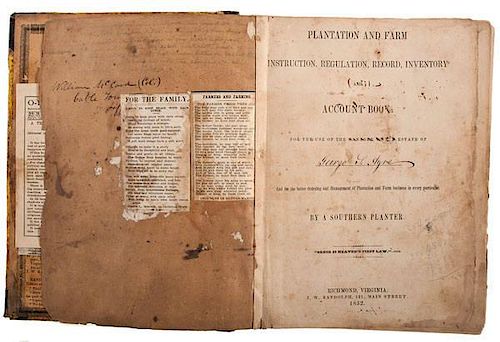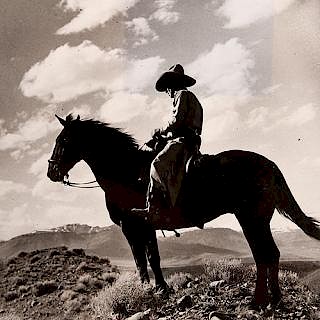Slave Plantation Ledger and Related Papers from Loudoun County, Virginia, Most Entries by George Stephenson Ayre, 1854-1858
About Seller
6270 Este Ave.
Cincinnati , OH 45232
United States
With offices in Cincinnati, Cleveland and Denver, Cowan’s holds over 40 auctions each year, with annual sales exceeding $16M. We reach buyers around the globe, and take pride in our reputation for integrity, customer service and great results. A full-service house, Cowan’s Auctions specializes in Am...Read more
Two ways to bid:
- Leave a max absentee bid and the platform will bid on your behalf up to your maximum bid during the live auction.
- Bid live during the auction and your bids will be submitted real-time to the auctioneer.
Bid Increments
| Price | Bid Increment |
|---|---|
| $0 | $25 |
| $500 | $50 |
| $1,000 | $100 |
| $2,000 | $250 |
| $5,000 | $500 |
| $10,000 | $1,000 |
| $20,000 | $2,500 |
| $50,000 | $5,000 |
| $100,000 | $10,000 |
About Auction
Jun 12, 2015 - Jun 13, 2015
Cowan's Auctions dawnie@cowans.com
- Lot Description
The lot features an exceptional slave plantation ledger, most entries identified to George Stephenson Ayre, whose plantation was a “safe house” for Col. John S. Mosby's raiders and the scene of the cavalry battle of Upperville in June 1863. The ledger is accompanied by an unrelated list of Confederate dead and wounded soldiers of the 8th VA Infy., plus some newspaper clippings.
The ledger is titled, "Plantation & Farm: Instruction, Regulation, Record, Inventory and Account Book for the use of the Estate of [manuscript] George S. Ayre." By a Southern Planter. Richmond, Virginia: J.W. Randolph, 1852. Approx. 8.5 x 10.5 in.
The first 19 or so pages of the book are instructions on managing a plantation - from managing livestock, rotating crops, planting distances, pounds to a bushel of various products, "Rules for the Government and Discipline of the Negroes," books that should be included in a reference library to be available to managers including medical references and medicines on hand, and even some physics (how long does a lever have to be to move a rock, for ex.). Then the pre-printed sheets have inventories of negroes, stock and implements, daily record, daily record of cotton picked, etc.
The journal is filled in for Rose Hill plantation, Loudoun County, VA for 1854. Pencil notation on front endpaper reads: "A Confederate Soldier name unknown was found Wednesday night June 24th (he had been killed in the fight of Sunday). Light hair, light mustache, no beard. Had on grey jacket, light pants, boots, light brown shirt, brown with red and blue stripes; red neck cloth made of a piece of sword-sash; light felt hat. Wooden buttons on jacket. Burried him where he was found under an oak tree alongside a rail fence, running along a wheat field. G.S. Ayre." This would have been the cavalry battle between the forces of Maj. Gen. JEB Stuart and Brig. Gen. Alfred Pleasonton on 21 June 1863 as JEB Stuart's forces hid along the fence lines on the Trappe Road - likely Ayre's fences among them. This action in part screened the movements of Robert E. Lee as he moved north into Pennsylvania, pulling Union forces away from the main body of the ANV.
Of the journal pages, Ayre has listed "only" ten slaves, total valuation, $5200. Journal entries include: [week of Jan 2, 1854] "All hands well and in place this morning...William & Tom hauling hay and feeding stock...Mrs. Ayre up to day for the first time for three days. Geo. started to school to Miss Lanham...All hands are yet at work on the cob mill. Sent three horses Walker's shop to shoe...Triplett fixing threshing machine...cutting wood & fencing..." [week Jan. 23] "Old Billy went to Rail Road and exchanged some wheat for Gibson...Mr Cumings died to day from a kick of a horse yesterday." [week Feb. 20th] "It was with great difficulty the cattle could be fed today. It is the deepest snow that I have ever seen averaging in the woods clear of drift 26 to 30 inches. All hands done nothing today but feed and brake [sic] tracks... The hands could do nothing not even feed but turned the cattle into the straw stacks...Nothing done but set in the house and read... The run was out of its banks but done no damage." [week March 20] "Two & four horse wagon went to R.Road and fetched home Guano... Planted the potatoes and sowed the oats and in the evening had two plows running in corn land ... The hands plowing and clearing off land from Day to Dark."
Ayres has also filled in some expenses for the year (pp 94-98). In place of cotton picked he has recorded work and the house and stone fencing. On p. 125 is a note: "I and my Father shook hands with Gen. Lafayette in Washington City in the fall of 1824 and he pated [sic] me on my head and congratulated me on making this country my future home. Geo. Stephenson Ayre."
Ayre has included an autobiographical pamphlet (4pp) (1899) and a longer booklet (14pp) with expanded details of the same information (1904) giving his view of the wrongs done to him during the war, in part seeking compensation. Also included are financial reports giving a detailed account of his losses.
Included among the papers stuck in the journal when found is a manuscript list of "Casualties in the 8th Virginia Regiment," suffered in a series of battles during the June Peninsular Campaign (Seven Pines to Gaines Mill). The 8th VA served with Pickett's Brigade in Longstreet's Division of the ANV. It is not clear what the relationship is, but there were two members of this unit with the last name "Ayre," J.T. and William Thomas. The list of killed and wounded indicates that J.T. Ayre was wounded "in the shoulder badly." The page has been folded into eighths, as if to fit in a common envelope of the day. Many of the men in the 8th VA were from Loudoun County, and even if J.T. was not a brother, he could have been a cousin or nephew. William Thomas was Ayre's oldest son (the 1860 Census says "William F." but this is likely an erroneous transcription of "T"). Although not on this list, HDS shows him as wounded on Darbytown Road, 6/30/1862, then again at Gettysburg on the 3rd day with a gunshot wound to the abdomen. Since he was badly wounded, he was taken prisoner, and died of his wounds as a POW on July 25.
George Stephenson Ayre was born 10 December 1817 in County Durham, England. His mother was a niece of the English engineer, George Stephenson, and the younger man was apparently named for him (George Stephenson had no children of his own, and likely doted on his nieces and nephews). Thomas Ayre, George's father, came to Washington City in 1819 and worked with John Seaford laying out and grading the streets of the city. Mary Ayre and her children followed in 1821.
George married Mary Ann Benton (1823-1904) of Loudoun County in 1841. The couple first lived in Fauquier County before purchasing the farm in Loudoun County ("Ayreshire"). Setbacks during the Civil War resulted in the loss of his plantation eventually. He died in 1912.
George Ayre in large part blamed the Federals for his losses on the plantation. Federal soldiers arrived and arrested him, robbing him of $70,000 Virginia Bank money and $9,000 Wheeling Bank money, as well as the deed for the farm, for which the money was intended. Indeed, when released from prison after nine months, he found his farm occupied by one Martin Maddox, who refused to leave. It took a court to rule that the land still belonged to Ayre, but Maddox still refused to leave. Ayre ended up giving Maddox $2000 to leave. Maddox took it and finally left, but this again added to Ayre's debt.
The man who "robbed" Ayre, one Captain Todd, was arrested, tried, convicted and dismissed from service. He took what did not belong to him and did not turn it over to the War Department. However, the consignor has done some research on this issue and argued that confiscation of property may have been justified (not for personal gain, however).
It would appear that Ayre's second son, George Hyde Ayre, listed as 14 years of age in 1860 (born 1846), joined one of the units that rode with Col. John Singleton Mosby as soon as he came of age. He was certainly riding with Mosby in Feb. 1864, when it was recorded that his horse was shot. Ayreshire was within Mosby's territory, north of Upperville in Loudoun County. Mosby is also known to have spent time in the Ayre home. Many of the plantations in the area were "safe houses" for Mosby and his men, and on many occasions Mosby came to dinner at Ayreshire or at least stopped in for the coffee which George S. kept on hand. One of Mosby's biographers, James J. Williamson ("Mosby's Rangers: A Record of Operations....") specifically credits George S. Ayre for aiding in filling in details where the author's records were lacking. As a Confederate supporter and sympathizer, Ayre was subject to losing his property. He was certainly not alone in this.
A view of the war from the border regions, from the standpoint of a Confederate. For a detailed look at the journal pages which are filled in and the pamphlets in the lot, go to: http://www.historybroker.com/collection/ayre/index.htm.P. 55/56 missing from book. Other pages loose or detached, but present. This is especially the case in front and back, with some damage to spine. Covers scuffed and spotted, pages toned with some water stains. Also front and back have various pamphlets and newspaper articles affixed. Generally readable. List of Confederate wounded and dead with some foxing and holes, but on good quality laid paper, so it has survived for the most part, and is very readable. Other items variable, most at least with some edge scuffing where they apparently protruded from the journal over the years.Condition
- Shipping Info
-
SHIPPING. At the request of the buyer, Cowan's will authorize the shipment of purchased items. Shipments usually occur within two weeks after payment has been received. Shipment is generally made via UPS Ground service. Unless buyer gives special instructions, the shipping method shall be at the sole discretion of Cowan's Auctions, Inc.. Cowan's is in no way responsible for the acts or omissions of independent handlers, packers or shippers of purchased items or for any loss, damage or delay from the packing or shipping of any property.
-
- Buyer's Premium



 EUR
EUR CAD
CAD AUD
AUD GBP
GBP MXN
MXN HKD
HKD CNY
CNY MYR
MYR SEK
SEK SGD
SGD CHF
CHF THB
THB


















